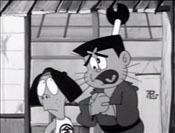Editor’s Note: Today I’m proud to introduce the debut of a new series of columns that I’m calling “LOST PLANET ANIME”. They will be written by our latest Cartoon Research contributor, cartoonist Charles Brubaker. This column will take a look at obscure or little known anime series (at least, unknown to me) and promises to be both fun and educational (again, at least for me). I was recently intrigued to determine which TV cartoon series were the last to be made in black and white. Charles turned my query into this inaugural post. If you’ve ever wondered about all those strange early anime shows, never seen in the US nor written about, I think you’ll enjoy this – as well as the future columns Charles has in store. – Jerry Beck

As we all know, everything was broadcast in black-and-white in the early days of television, and that up until the mid-to-late 1960s most television programs were filmed in monochrome hues.
One of the exceptions to this rule were the (then new) made-for-TV cartoons. Sure, they may have broadcast Rocky and His Friends, Huckleberry Hound, and The Flintstones in black and white when they first aired, but they were produced and filmed in color. As animator Mike Kazaleh explained to me, film stock was a relatively small part of the animation budget, so the producers figured they might as well shoot them in color because, hey, color TV was inevitable anyway. As we now know, this was a very wise decision. The fact that they were shot in color greatly helped their rerun cycle.
It was different in Japan, however. TV animes made in the 1960s, such as Astro Boy, 8th Man, and Gigantor, were all shot in black and white. While there were color animes as early as Kimba the White Lion, there were still black and white shows being made as late as 1970. It was only until that year that every anime became color productions.
So what were the last black and white anime series? Well, that depends on how you phrase the question. Do you mean what was the last black and white anime to “air”? Or do you mean the last black and white anime to be MADE? I’ll explain both questions.
The year 1969 saw the debut of sixteen animated series on Japanese TV. Of that, three were filmed in black and white. Those three were:
Umeboshi Denka (Studio Zero and Tokyo Movie, 26 episodes). A royal family from outer space land on Earth after their planet was destroyed. Taken in by a human family, they get into comedic misadventures. Based on a manga created by Fujiko Fujio (joint pseudonym of Motoo Abiko and Hiroshi Fujimoto). The show’s production was split between Studio Zero and Tokyo Movie, with Zero producing odd-numbered episodes (episodes 1, 3, 5, etc.), while Tokyo Movie did even-numbered episodes (episodes 2, 4, 6, etc.). This production arrangement was previously done on Perman (1967) and Kaibutsu-Kun (1968), both shows also based on Fujiko Fujio’s comics.
Here are the opening credits to Umeboshi Denka:
Moretsu Ataro (Toei Doga, 90 episodes). Misadventures of orphan named Ataro, who must run his family’s vegetable shop with the help of his friend Dekoppachi and the ghost of his father. Later episodes heavily feature a talking cat named Nyarome, who became more popular than the main character himself. Based on a manga created by Fujio Akatsuka, who is regarded as the pioneer of “gag manga” (gag-heavy Japanese comics).
The original b/w opening is embed below:
Dororo (Mushi Production, 26 episodes). One of the many series created by Osamu Tezuka. A baby, who is later dubbed Hyakkimaru, is born without 48 body parts, due to a pact his father made with the demons before he was born. Before he could be left for dead, however, a doctor took him in and gave him prosthetic body parts. With the help of a young boy known as ‘Dororo’, Hyakkimaru swears to kill the demons responsible in order to reclaim his missing body parts.
Here is the opening of Dororo:
All three shows debuted in April 1969: Umeboshi on the 1st, Ataro on the 4th, and Dororo on the 6th. It’s a safe bet that all three entered production roughly at the same time. Dororo is the last of the bunch to debut, so one could argue that’s the last one.
But if we are to ask ourselves what the last B&W anime to be MADE is, then that title goes to Moretsu Ataro. Both Umeboshi Denka and Dororo were cancelled before the year was over, just five months later in September.
Moretsu Ataro aired for a whopping 90 episodes, ending its run on Christmas Day, 1970. However, it needs to be noted that the final 13 episodes were shot in color. The 77th episode, the last one done in black and white, aired on September 25, 1970; starting with the following week’s episode, the show was broadcast in color (the color opening sequence can be viewed here).
Okay, so we know what the last one MADE in black and white is, but what about the last one that AIRED on TV?
 Sometime around 1968, Tokyo Movie produced a show called Chingo Muchabei. Based on a manga by Kenji Morita, this gag-anime series featured a poor umbrella maker protecting a disinherited prince from a group of ninjas sent by the royal leader bent on destroying him. By the time the show was ready for broadcast, Japan had started to embrace color TV and there were fewer and fewer timeslots for black and white shows. As a result, this show sat on the shelf, waiting for an open timeslot.
Sometime around 1968, Tokyo Movie produced a show called Chingo Muchabei. Based on a manga by Kenji Morita, this gag-anime series featured a poor umbrella maker protecting a disinherited prince from a group of ninjas sent by the royal leader bent on destroying him. By the time the show was ready for broadcast, Japan had started to embrace color TV and there were fewer and fewer timeslots for black and white shows. As a result, this show sat on the shelf, waiting for an open timeslot.
Even though all 26 episodes of Muchabei was completed before Umeboshi Denka even entered production, it wasn’t until 1971 that the anime finally aired on TV. The network had a 6pm weekday slot dedicated to reruns of cancelled anime, and since there were no longer any weekly black and white slots in TV schedules, the network had to make due by airing it as a “rerun”, even though this was the first time the general public had even seen the show. As a result, every episode of Muchabei was shown in a period of one month (February 15 to March 22, 1971). After the last episode aired, the show was replaced by a rerun of another anime, and that was the last time anyone has seen it…until 2010, when a satellite channel reran the show for a brief time.
Below is the opening titles for Chingo Muchabei (a textless version of the end titles are here; and entire episode of this obscure series (in Japanese) is posted here).


 Charles Brubaker is a cartoonist originally from Japan. In addition to his work for MAD Magazine and SpongeBob Comics, he also created Ask a Cat for GoComics. You can also follow him on his Tumblr page.
Charles Brubaker is a cartoonist originally from Japan. In addition to his work for MAD Magazine and SpongeBob Comics, he also created Ask a Cat for GoComics. You can also follow him on his Tumblr page.











































When Osamu Tezuka visited the C/FO in 1978, he showed a pilot of Dororo in color. But his Mushi Pro studio was unable to sell Dororo for enough to produce the series in color, so it ended up as a black-&-white series. His Dororo proposal was also for a longer series — 39 episodes, I think, though it may have been for 52 — but again no TV station would pay enough to make more than 26 episodes. Tezuka’s complete story is in his manga of it. The theme song by Isao Tomita was certainly memorable.
That was a good theme song Fred, I love listening to it.
There definitely is a lot of history to mine here. I’m looking forward to further installments.
It is a shame there wasn’t an afterthought to shoot in color has they had the extra money to do it. Just like some American live-action programs in the mid 60’s, you get a few of these cartoons being produced where they’re either all B&W, or some switch over to color during production like Moretsu Ataro (no doubt someone flip the bill). Not it hampered future use of these shows in rerun distribution/syndication, but it is something I bother to think about for whatever reason.
I remember “Prince Planet,” a B&W anime series, telecast in the mid- to late ’60s on one of Boston’s independent stations. I was a big fan. The voice acting was execrable, and the animation was as choppy as any ’60s anime, but some of the plots were actually quite good — and occasionally quite dark. Postings of individual episodes can be seen now and then on YouTube.
MGM has made the series available (at least 47 episodes) on both Hulu and YouTube for all to see. At least it use to be up on YouTube but I guess that window of opportunity has expired now.
http://www.hulu.com/prince-planet
I got these shockingly mildewy cels [click here] from Dororo for an understandeably low price.
I developed an interest in the series… ok, I actually don’t recall if it was because of the PS2 game (Blood Will Tell) based on it, or vice versa…
Either way, the game came out and interested plenty.
Color cartoon were easier to produce than Black and White. The poor person who does the Color Key have to deal with working with shades of Gray where as color is very self explanatory. Plus the majority of the cartoons were shot in Techincolor which was cheaper and very easy to do in animation since you are dealing with still flat artwork and a single strip of Black and White film and three frames shot through the RGB filters rather than three-strips that was required with the live action camera. A lot of studios continued to do this until the 60’s but Disney, from what I heard, continued to use this method with their flat 2-D animation to protect the original negatives.
Obviously the Japanese could’ve benefited from that but it wasn’t in their frame of reference I suppose.